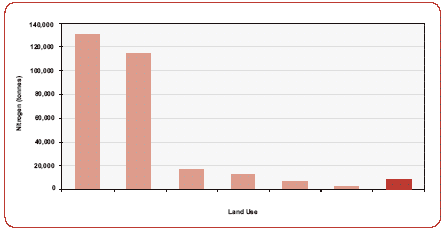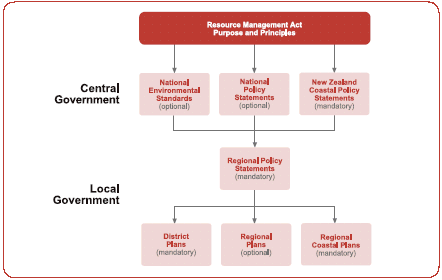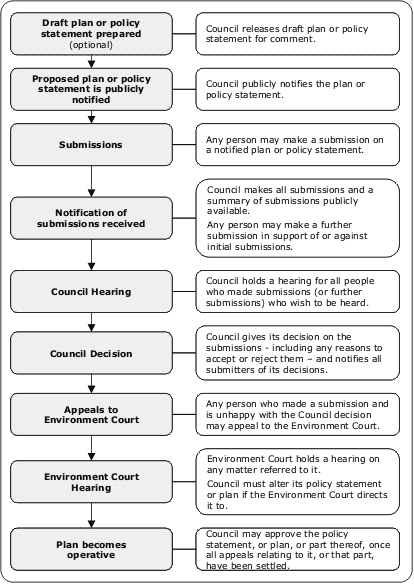Part 2: Water, the Resource Management Act, and the planning framework
- Water quality and quantity
- The Resource Management Act 1991
- Contents of planning documents
- Preparation of planning documents
- Role and functions of local authorities for freshwater management under the Resource Management Act
2.1
New Zealand’s unique natural environment contributes to the country’s reputation for scenic beauty, recreational opportunities, and a “clean, green” image. However, the activities of people can and do affect the quality of that environment.
2.2
This report discusses how the selected 2 regional councils use the RMA framework to manage activities that affect the quality and quantity of freshwater resources in their regions.
2.3
In a 2004 survey of public perceptions of the environment5, respondents considered rivers and lakes to be among the least well managed of the 11 components of the environment studied. The management of farm effluent and run-off was perceived to be the least well managed of the specific environmental problems investigated by the survey.
2.4
Compared to a previous survey in 2002, there was a 96% increase6 in the number of respondents who judged water pollution to be the most important environmental issue facing the country.
2.5
According to the Quality Planning website – www.qp.org.nz – clean, abundant freshwater is a key element of:
- economic prosperity – for power generation, industrial processes, agriculture, irrigation, and tourism;
- health – for drinking, bathing, and cleaning;
- environmental values – for recreation, fishing, biodiversity, nutrient recycling, and climate regulation; and
- cultural identity – for collection of food and weaving materials, and preservation of mauri and kaitiakitanga.
Water quality and quantity
Water quality
2.6
In the past, it was common practice to discharge contaminants directly into rivers, streams, lakes, and other water bodies. These point source discharges (such as factory or wastewater treatment plant7 outfalls) are now largely controlled under the RMA.
2.7
More difficult to deal with are non-point source discharges, which enter freshwater either:
- directly – from stormwater, run-off from agriculture, forestry, or farmland that contains contaminants such as fertiliser, animal waste, or sprays, and from eroding soil that is washed from the land into freshwater; or
- indirectly – from nutrients (for example, fertiliser or animal waste) which leach through the soil into groundwater, and eventually into lakes and rivers.
2.8
These discharges are difficult to manage because it is hard to establish a direct link between the contaminant and its source. The cumulative environmental effects of non-point source discharges are often significant.
2.9
The Parliamentary Commissioner for the Environment notes in his 2004 report Growing for Good8 that–
New Zealand’s waters are a limited, fragile resource coming under increasing pressure from farming activities, both in terms of the effects on water quality and the increasing demand for water. Although pollution of rivers from point sources … has declined over the last 20 to 30 years, pollution from non-point sources is a major and increasing problem. Farming has been identified as the main source of pressure on water quality in New Zealand.
2.10
Contaminants such as animal waste, fertilisers, soil erosion, septic tank leachate, and sewage contain the nutrients nitrogen and phosphorus, which are needed for aquatic plant growth.
2.11
However, too much nitrogen and phosphorous in the water can cause excessive plant growth (which makes swimming unpleasant and deprives fish of oxygen), and toxic algal blooms (which affect the central nervous system and liver, and could kill livestock, wildlife and humans).
2.12
Sustained levels of nitrogen in the form of ammonia can be toxic to fish. High levels of nitrates and nitrites can make water unsafe for human and livestock consumption.
2.13
Figure 1 shows how many tonnes of nitrogen leached as a result of various land uses in 2001, compared to that from point source discharges.
Figure 1 - Nitrogen leaching from various sources in New Zealand in 2001*

* Parfitt, R., Schipper, L.A. and Baisden, W.T. 2005, National nitrogen budgets for New Zealand in 2001 – a first approximation, in Developments in fertiliser application technologies and nutrient management (Eds L.D. Currie and J.A. Hanly), Occasional Report No. 18, Fertiliser and Lime Research Centre, Massey University, Palmerston North, New Zealand (in press).
2.14
While agricultural activities appear to affect water quality the most, urban discharge of sewage and industrial waste, and stormwater, also affects water quality.
2.15
Towns of more than 5000 people have a reticulated sewage system which pipes wastewater to a treatment plant. This treated effluent is ultimately discharged to rivers or the sea. Only a small percentage of urban wastewater is disposed of onto land. On-site wastewater treatment (using septic tanks) is used in small towns and beach communities. This can be an efficient form of sewage treatment, but if septic tanks malfunction, undesirable levels of contaminants can enter nearby waterways.
2.16
Wastewater is also discharged by industry, either into a reticulated wastewater system or directly to rivers or coastal waters.
2.17
Urban stormwater can also be a significant source of pollution. Where rainwater is not absorbed by soil and vegetation, it runs over paved surfaces, is mixed with contaminants such as sediment or oil, then enters gutters and drainage pipes, where it eventually discharges into streams, lakes, or coastal waters.
2.18
Whether they are from a point source or non-point source, discharges of contaminants into our waters are of concern because they affect aquatic health, visual amenity, or pose a risk of contact-related illness – for example, vomiting, diarrhoea, or skin infections.
Water quantity
2.19
Water takes9 for municipal and domestic use comprise only 0.2% of annual national rainfall. Two-thirds of the water for municipal and domestic use is taken from surface water, and the remainder from groundwater.10
2.20
The increasing demand for freshwater to generate hydro-electricity and to irrigate is placing pressure on local and central government to put processes in place to manage allocation of freshwater for consumption, storage, and use.
2.21
“Out of stream” uses of water (such as irrigation) can reduce the ability of our waters to sustain wildlife, and the quality of tourist attractions, water-based recreational opportunities, and cultural values.
2.22
Rivers, in particular, can be put under considerable stress during summer periods, when demand for irrigation water is high. The sustainable management of water requires an adequate residual flow in rivers to safeguard fish and wildlife habitats and provide for other environmental values.
2.23
A reduction in water volume also reduces the ability of the river or stream to cope with contaminants.
The Resource Management Act 1991
Purpose and principles
2.24
The RMA is the country’s principal environmental legislation, and sets a framework for the “sustainable management” of land, air, and water.
2.25
The RMA defines “sustainable management” as–
… managing the use, development, and protection of natural and physical resources in a way, or at a rate, which enables people and communities to provide for social, economic, and cultural well-being and for their health and safety, while:
- sustaining the potential of natural and physical resources (excluding minerals) to meet the reasonably foreseeable needs of future generations; and
- safeguarding the life-supporting capacity of air, water, soil, and ecosystems; and
- avoiding, remedying, or mitigating any adverse effects of activities on the environment.
2.26
The RMA sets out “matters of national importance” which must be recognised and provided for by all persons who exercise functions and powers under the Act. These include:
- the preservation and protection of the natural character of wetlands, and lakes and rivers and their margins;
- the protection of areas of significant indigenous vegetation and significant habitats of indigenous fauna;
- the maintenance and enhancement of public access to lakes and rivers; and
- the relationship of Māori and their culture and traditions with their ancestral lands, water, sites, wāhi tapu, and other taonga.
2.27
The RMA also requires all persons exercising functions and powers under the Act to have particular regard to (among other things):
- kaitiakitanga;
- the efficient use and development of natural and physical resources;
- the maintenance and enhancement of amenity values;
- intrinsic values of ecosystems;
- maintenance and enhancement of the quality of the environment;
- any finite characteristics of natural and physical resources; and
- the protection of the habitat of trout and salmon.
2.28
In addition, all persons exercising functions and powers under the Act are required to take into account the principles of the Treaty of Waitangi (Te Tiriti o Waitangi).
2.29
The RMA imposes a duty on all people to avoid, remedy, or mitigate adverse effects on the environment. The Act also contains restrictions on discharging contaminants into water and on the taking, use, damming, or diversion of water, and certain uses of the beds of lakes and rivers.
2.30
The RMA sets out the planning framework for the management of natural and physical resources. This is outlined in Figure 2.
Figure 2
The Resource Management Act’s planning framework

National Environmental Standards and National Policy Statements
2.31
The RMA allows the Minister for the Environment to prepare National Policy Statements – to guide local authorities on matters of national significance, and National Environmental Standards, which have the force of regulation and are binding on local government.
2.32
There is only one National Policy Statement – the New Zealand Coastal Policy Statement – and one set of National Environmental Standards relating to air quality. There are currently no National Policy Statements or National Environmental Standards for freshwater quality or quantity.
Regional Policy Statements
2.33
Regional councils must produce Regional Policy Statements. These are high-level documents that provide an overview of the resource management issues of the region, and policies and methods to achieve integrated management of the natural and physical resources of the whole region. Regional Policy Statements must be reviewed no later than 10 years after they become operative.
Regional Plans
2.34
A regional council must prepare a Regional Coastal Plan, and may also prepare a Regional Plan for the whole or part of its region for any function related to:
- soil and water quality and quantity;
- management of natural hazards;
- control of discharges of contaminants into or onto land, air, or water, and discharges of water into water;
- maintaining indigenous biological diversity; and
- any other functions specified in the RMA.
2.35
Regional plans can assist councils to carry out their functions by specifying objectives, policies, methods, and rules, which allow, regulate, or prohibit certain activities. Regional plans can be particularly important for water management by placing restrictions on activities involving water and the disturbance of beds of rivers and lakes. This means that most water-related activities are prohibited unless they are expressly allowed by a rule in a regional plan or resource consent.11
2.36
A regional council must not set standards in a regional plan that result, or may result, in a reduction in the quality of the water unless it is consistent with the purpose of the RMA to do so.12
District Plans
2.37
Territorial authorities (city and district councils) must produce District Plans, which set objectives, policies, and methods to achieve integrated management of the effects of the use, development, or protection of land and associated natural and physical resources of the district. District Plans must not be inconsistent with the Regional Policy Statement of the region or a Regional Plan.13
Contents of planning documents
2.38
Regional Policy Statements and Regional and District Plans (referred to in this report as planning documents) must include (among other things):
- issues – an existing or potential problem that must be resolved to promote the purpose of the RMA;
- objectives – a statement of what will be achieved through resolution of the issue;
- policies – an intended action or attitude towards an issue;
- methods – the way the policy is implemented (these can be regulatory or non-regulatory); and
- Environmental Results Anticipated (ERAs) – what might be achieved from the combined effect of the objectives, policies, and methods.14
2.39
Regional and District Plans may also include rules which have the force of regulation.
Preparation of planning documents
2.40
The process to prepare planning documents is set out in Schedule 1 of the RMA. It involves public notification of planning documents, and allows for the public to make submissions to which a local authority must respond. If a person is unhappy with a local authority’s decision about his or her submission, that person may appeal to the Environment Court. The Environment Court can direct the local authority to amend a planning document if appropriate.
2.41
The process for preparing planning documents is illustrated in Figure 3.
Figure 3
Process for preparation of planning documents

Role and functions of local authorities for freshwater management under the Resource Management Act
2.42
The RMA sets out the functions, powers, and duties of local authorities in relation to the management of natural and physical resources. Functions and powers for freshwater management lie with regional councils. Other regional council functions that relate to freshwater management include management of soil and geothermal resources, the control of pollution, and the use of land as it affects natural resources.
2.43
Territorial authorities are responsible for the management of the effects of the use, development, or protection of land, and associated natural and physical resources of the district. Territorial authorities also control any actual or potential effects of activities in relation to the surface of water in rivers and lakes.
2.44
In terms of freshwater, regional councils have the power to control:
- the use of land for the purpose of:
- the maintenance and enhancement of the quality of water in water bodies;
- the maintenance of the quantity of water in water bodies; and
- the maintenance and enhancement of ecosystems in water bodies;
- the taking, use, damming, and diversion of water, and the control of the quantity, level, and flow of water in any water body, including:
- the setting of any maximum or minimum levels or flows of water;
- the control of the range, or rate of change, of levels or flows of water; and
- the control of the taking or use of geothermal energy;
- the discharge of contaminants into or onto land, air, or water, and discharges of water into water; and
- in relation to any bed of a water body, the control of the introduction or planting of any plant in, on, or under that land, for the purpose of:
- the maintenance and enhancement of the quality of water in that water body; and
- the maintenance of the quantity of the water in that water body.
2.45
Regional councils and territorial authorities must monitor the:
- effectiveness and efficiency of policies, rules, or methods in Regional Policy Statements or Regional Plans;
- exercise of resource consents;
- exercise of delegated or transferred functions and powers; and
- the general state of the environment.
2.46
In addition, the RMA states that regional councils and territorial authorities must take appropriate action (in response to monitoring undertaken) where it is shown to be necessary.
5: Hughey, K.F.D., Kerr, G.N. and Cullen, R. 2004. Public Perceptions of New Zealand’s Environment: 2004. EOS Ecology, Christchurch 102pp. ISBN 0-476-01265-1.
6: In 2002, 678 people answered this question and 47 considered that water quality/pollution was the most important environmental issue facing New Zealand. In 2004, 670 people responded to this question and 91 selected water quality/pollution as the most important environmental issue facing New Zealand.
7: A system for processing human domestic waste and/or sewage.
8: Parliamentary Commissioner for the Environment, Growing for Good: Intensive farming, sustainability and New Zealand’s environment, October 2004.
9: The term “water take” refers to the extraction of water from a water body.
10: Statistics New Zealand, Water Physical Stock Accounts for the years 1995 to 2001, Inaugural Report, 2004.
11: A resource consent is a permit to carry out an activity that would otherwise contravene the RMA. Requirements included in the resource consent are known as resource consent conditions.
12: RMA, section 69.
13: RMA, section 75(2).
14: Ministry for the Environment, Drafting Issues, Objectives, Policies and Methods in Regional Policy Statements and District Plans, 2003.
page top